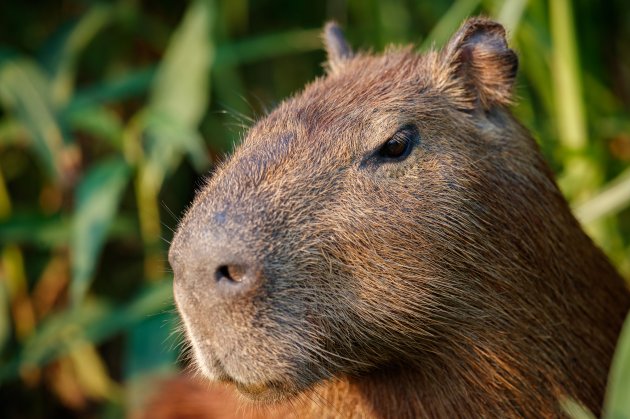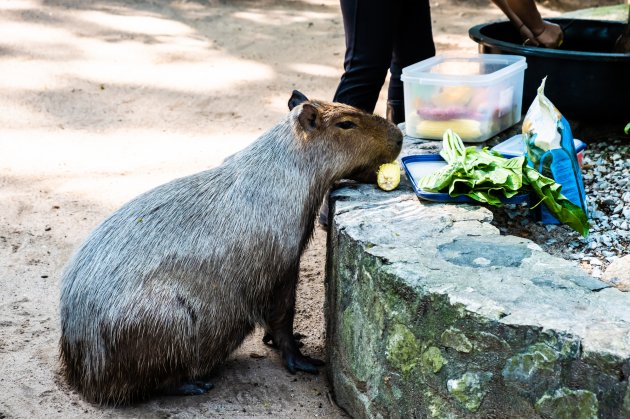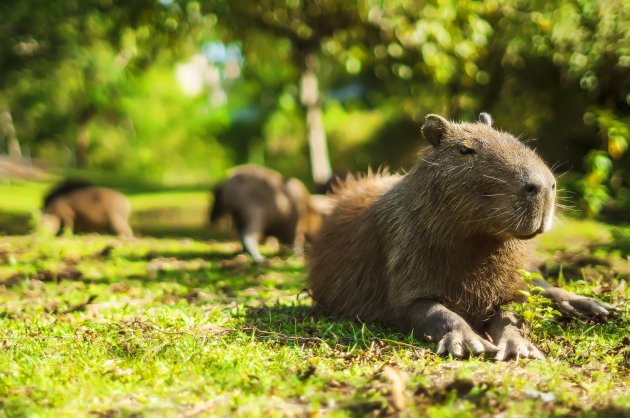The Capybara is the largest rodent in the world - it kind of looks like a giant guinea pig. However, unlike its smaller cousin, (which is relatively easy to keep as a pet), the capybara will need some very specific care. And, you will also need to double that care because it is recommended that they are kept in pairs (more on that later).
Read on for important information on keeping the capybara as a pet.

The Appearance of the Capybara
The capybara has a stocky body covered in short coarse fur ranging in color from pale to dark brown with tinges of yellow, red or grey. The head of this rodent is blocky and relatively small in comparison to the rest of its body. Its eyes, ears, and nostrils are all positioned higher up on the head, so they still can use all their senses while in the water.
Their short sturdy legs end in hoof-like claws with webbing that enable this animal to navigate slippery banks and muddy lake bottoms. The capybara is also an excellent swimmer and loves to spend most of its time in the water.
The ever-growing teeth of this animal are extremely sharp. It has two large top and two large bottom teeth that are beaver-like in appearance and are well adapted to eating grasses and other course foods.
Capybara Fast Facts
- Weight: Up to 170 pounds
- Height: 2 feet tall
- Lifespan: 8 to 10 years
- Native: Central and South America
The Behavior of the Capybara
In the wild, capybaras form large groups, as they are very social creatures. They have unusually dry skin, so they want to spend a great deal of time submerged in water. In fact, they can hold their breath for five minutes. The capybara also enjoys covering itself in mud and does so to help prevent sunburn.
Because of their need for the company of at least one other capybara, you will need to keep this pet in pairs. However, two males may fight if your enclosure is too small even if they are neutered.
The capybara is very vocal and will emit sounds from purring, whistling, clicking, grunting, and when in “alarm-mode,” barking like a dog.
If you think the size of the capybara makes it a lazy pet, think again. This animal sleeps very little, dozing in the wild whilst grazing on grass, or lounging in the cool water or mud.
Housing the Capybara
Unlike a guinea pig, you will need a significant amount of room for your capybara pair. Experts recommend a fenced-in enclosure measuring a minimum of 12 by 20 feet with a minimum 4-foot high solid fence. You will also need an enclosure for warmth and safety if you are not bringing your capybaras indoors at night.
As we discovered earlier, the capybara has sensitive skin and thin fur, so you will need a pool (at least 3-feet deep) for your pets to lounge in during the hot months, as well as a shaded area to retreat to.
Within your capybara enclosure, you will need to scatter fresh hay for grazing, untreated wood for chewing on, and large, durable dog toys that can be picked up or used as “floaters” in the pool.
Since the capybara is native to warm climates, if your weather is inclement you will need to provide this rodent with a heat lamp and a UVB lamp to mimic the sunlight for at least 12 hours each day.

Feeding a Capybara
It’s important to get as close to the capybara’s wild diet as possible. To do this, you will need to feed your pet high-quality grass hay (such as Orchard hay and Timothy hay) in unlimited piles. These hays will provide your capybara with both roughage, and the ability to keep its teeth at a healthy length.
If your property is appropriate for grazing, you can allow your capybara to graze off of the land; however, there must be no chemicals, pesticides or fertilizers in the grass.
In addition to these natural grasses and hays, your capybara will also need guinea pig pellets with added vitamin C (this animal cannot produce enough vitamin C naturally), so you will have to ensure a supplement is given or the guinea pig pellets are fortified with “C.”
Capybaras also enjoy the occasional veggie treat, but try to avoid those that are sweet, as they can become addicted to the natural sugars.
How can you tell if your capybara’s diet is healthy? Its droppings will be olive-shaped. If not, examine what you are feeding him and adjust accordingly.
Handling a Capybara
Always be sure to obtain your capybara from a reputable breeder. NEVER snatch one out of its natural habitat as this is very stressful for the animal.
Hand-reared capybaras tend to be more relaxed with humans, but you will still want to handle it with care and give it time to adjust to its new home. Again, you should always have at least two capybaras, as one will become depressed, lonely and ill.
If you are adopting a capybara as an adult, you may have to give it time to “warm up to you.” Use food rewards, comb its fur, and imitate it’s social sounds, to help your capybara become a friendly family pet.

Fun Capybara Facts
Want to learn more about this exotic pet? Check out these fun capybara facts!
- In the Tupi language, capybara means “one who eats slender leaves.”
- Capybaras hop because their back legs are slightly longer than their front legs.
- In the wild, this animal forms groups from 10 to 20 members. This group includes males, females and their babies.
- This rodent can sleep in the water, while still keeping its nostrils free to breathe.
- Birds, monkeys and other capybaras all use this animal as a furry ottoman. And they don’t even mind it!
- Capybaras love the hot springs in Japan.
- This rodent uses its scent glands to find its way back home after a long day of foraging for food.
The Capybara & You
Now that you know all about the capybara, perhaps you’re ready to embark on pet parenting a pair? Before you do, be sure this rodent is legal in your area, as some states have prohibited the ownership of the capybara. You will also want to find a reputable breeder, then meet the proper housing and dietary requirements of this pet.
Having a capybara as a pet can be exciting as long as you go into it knowing all the facts.
Further reading and references:
- Lolly Brown. (Mar 6, 2014). Capybara. Facts & Information: Habitat, Diet, Health, Breeding, Care, and Much More All Covered. Retrieved from amazon.com
- Rexford D. Lord. (Sep 1, 2009). Capybaras: A Natural History of the World's Largest Rodent. Retrieved from amazon.com
- Guillermo R. Barreto, Rubén D. Quintana. Capybara